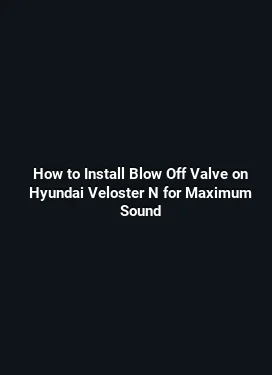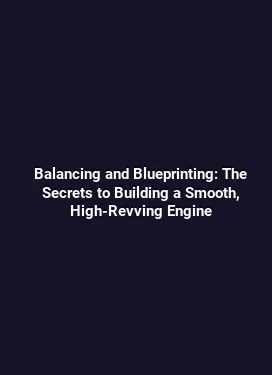DIY Turbo Installation Guide for Mazda Miata NA 1.6L with Dyno Results
Baseline Power and Target Performance

The Mazda Miata NA 1.6L is widely praised for its lightweight chassis, balanced handling, and simple, rugged intake and exhaust flow. In stock form, most NA Miatas roll off the line with roughly 105 to 115 horsepower at the crank, depending on the year and market calibration. On a typical chassis dynamometer, a well-maintained example often records wheel horsepower in the 90 to 105 hp range with stock boost, exhaust, and intake configurations. The goal of a turbo upgrade is not only about peak numbers; it is about repeatable, predictable power delivery that complements the car’s limited-slip geometry, rev-happy temperament, and light inertia.
With a thoughtfully matched turbo kit, the practical target is to reach a usable power band that remains street-friendly. A realistic, streetable range might be 180 to 230 wheel horsepower, achieved with controlled boost levels, proper fueling, and an ECU strategy that retains reliability under daily driving conditions. The exact numbers depend on the turbo sizing, fuel system upgrades, intercooling efficiency, and the quality of the install. A well-planned baseline dyno run establishes a reference point, and subsequent tuning sessions reveal the true gains and any bottlenecks in the system.
Choosing a Turbocharger and Supporting Components

Selecting a turbocharger begins with the intended power target and the engine’s breathing characteristics. A smaller turbo spools quickly and builds boost early, delivering a lively torque response that helps with street drivability. A larger turbo can push higher peak horsepower but may introduce lag and heat management challenges. For the NA 1.6L, many builders opt for a compact to mid-size turbo that can reliably produce 8–12 psi of boost on pump fuel while preserving spool in the 2,500–3,500 rpm band. The supporting hardware—intercooler size, piping layout, wastegate type, blow-off valve, oil feed and return lines, and a proper fuel delivery upgrade—defines how cleanly that boost translates into power.
Supporting components include a front-mount or top-mmount intercooler with efficient air guiding, flexible aluminum charge pipes, a reliable blow-off valve rated for the chosen boost, and a robust wastegate with a predictable spring rate. A dedicated fuel system upgrade, such as larger injectors and a high-flow fuel pump, ensures air-fuel ratios stay safe under boost. The engine management approach—whether a dedicated ECU, a tuned piggyback, or a standalone system—determines how well timing, fueling, and boost are harmonized across the operating range.
Turbo System Selection and Sizing
Turbo system selection centers on the balance between fast response, peak power, and overall reliability. A kit that includes a matched compressor map, turbine housing, and a suitable intercooler helps minimize lag while sustaining stable boost control. For many builds, a bolt-on turbo kit designed for the Miata platform reduces custom fabrication and improves reliability. When sizing, consider the target horsepower at the wheels, the boost strategy, and the ability to maintain safe air-fuel ratios under heavy load. Remember that the NA engine’s compression ratio and head design influence how aggressively it can respond to boost without detonation.
Boost control strategy matters as much as the turbo itself. A conservative approach—targeting modest boost with progressive fueling—often yields the most repeatable dyno results and street driveability. It is essential to plan for heat management; turbocharged engines generate more heat, and cooling must be addressed through airflow, intercooling, and oil temperature management to avoid heat soak during longer pulls or hot-weather operation.
Turbocharger Options and Supporting Hardware
Options range from compact, quick-spooling units to mid-size turbos designed for higher horsepower targets. A common choice is a small-to-mid turbo with a mid-range A/R ratio and a compressor wheel that matches a practical injector size for the 1.6L. The corresponding turbine housing should complement the exhaust curve so that spool is predictable and peak power remains achievable without forcing extreme exhaust gas temperatures. Support hardware includes an efficient intercooler, resonated charge pipes to reduce intake noise, a reliable fuel pump, and appropriate injectors sized for the expected fueling window. A robust oil supply line, a return line sized for the chosen turbo, and a secure water or oil cooling path for the center section help preserve durability under sustained boost.
The choice between internal and external wastegates influences packaging and boost stability. Internal gates are compact and simpler to install, while external gates offer precise flow control at higher boost levels. For a street-focused NA Miata, an internal or a light external gate paired with a well-chosen compressor map often yields a reliable, linear boost response across the RPM range.
Matching Turbine Housing, Compressor, and A/R Ratios
Compressor size should align with desired horsepower and air density at altitude. A typical target for a 1.6L engine building around 180–230 wheel horsepower is a turbo in the 360–550 cc/min compressor range with a small-to-mid turbine housing. The A/R ratio of the turbine housing affects spool characteristics and top-end flow; a lower A/R reduces backpressure and helps the engine reach peak torque sooner, while a higher A/R favors top-end power at the expense of lag. Balancing these elements requires evaluating combustion efficiency, intercooler effectiveness, and the engine’s overall thermal management plan. Collecting data from a controlled dyno session with progressive pulls helps verify the pairing before finalizing the setup.
Fuel, Engine Management, and Tuning
Upgrading the fuel system is essential when increasing air intake via boost. The Miata’s stock injectors and fuel pump are not sized for sustained boost beyond factory levels, so injector sizing must be matched to the estimated air mass the turbo will deliver. With pump gas in many regions, injector upgrades in the 360–750cc range are common for setups in the 180–230 wheel horsepower band, depending on efficiency and turbo choice. Fuel pressure regulation, return-style fuel systems, and proper rail geometry all contribute to stable, predictable fueling under boost. A meticulous approach to fueling reduces the risk of lean hotspots that can lead to detonation under load.
Engine management is the critical element tying together boost, fueling, and timing. A properly tuned ECU or standalone system maps ignition timing to RPM and load, adapts fueling to air density and temperature, and governs boost ramp rates. For road durability, it is important to implement safe timing curves that mitigate detonation risk at higher intake temperatures and under sustained boost. Idle stability, cold-start behavior, and smooth transition between boost modes are practical indicators of a well-tuned system.
Fuel System Upgrades
Fuel upgrades commonly include higher-flow injectors, a pump capable of delivering increased fuel volume at hang-dry conditions, and a more rigid fuel line routing to prevent pressure drops during hard acceleration. Using a fuel pressure regulator with a returnless or return-style setup helps keep rail pressure stable as boost climbs. It is prudent to plan for fuel system熱 margins that account for potential future upgrades, allowing for a more straightforward re-tune if aiming for higher horsepower levels down the line.
Engine Management and Tuning Approach
A step-by-step tuning approach begins with a safe baseline on low boost, verifying air-fuel ratios and ignition timing at idle and cruise. Progressive boost is introduced with small, incremental increases, while monitoring for detonation, knock, and fueling stability. A dyno session helps map optimum timing across RPM and load cells, ensuring that fuel trims stay within safe limits. It is useful to document changes with each run, keeping a clear record of boost level, injector duty cycle, and sensor feedback to guide subsequent tuning decisions.
Airflow, Intercooling, and Piping
Efficient air handling is key to converting the turbo’s potential into real-world power. An appropriately sized intercooler reduces intake air temperatures, preserving density and reducing the likelihood of pre-ignition. Charge piping should be smooth and free of restrictions, with carefully placed bends to minimize pressure loss. The routing should avoid heat sources and maintain shielded paths where possible to reduce radiant heat transfer to the intake tract.
Inlet tract design also matters. A well-designed intake pipe reduces throttle-induced turbulence and helps the ECU predict airflow more accurately. A direct-path intercooler, with minimal piping length and a low-pressure drop, tends to yield stable horsepower gains across the RPM range. Monitoring intercooler temperatures during sustained pulls provides insight into how much headroom remains before heat soak begins to degrade performance.
Intercooler Sizing and Piping Layout
Intercooler sizing depends on engine displacement, turbo size, and desired heat rejection at typical ambient temperatures. For a 1.6L engine, a compact, efficient intercooler with a suitable core area can provide ample cooling without adding excessive front-end weight. Piping layout should minimize sharp transitions and unnecessary length. Silicone couplers, clamped joints, and protective shielding help maintain reliability under street and track conditions. A properly sealed system prevents boost leaks that can masquerade as fueling or timing issues during tuning.
Cooling, Lubrication, and Reliability
Turbocharging increases thermal load on the engine and lubrication system. Maintaining oil temperature is critical, especially during hot days or track sessions. An upgraded cooling strategy—adequate radiator capacity, efficient fans, and perhaps an external oil cooler—helps maintain stable temperatures and protects engine bearings and turbo bearings from heat-related wear. Keeping oil pressure within the recommended range under boost is essential for longevity and consistent oil scavenging from the turbo’s oil supply.
Reliability also benefits from careful servicing intervals and inspection routines. Regularly inspecting turbo oil lines for leaks or blockages, ensuring fasteners stay secure after road use and occasional track days, and verifying intercooler piping for cracks or leaks all contribute to a durable build. Proper engine cooling and a robust oiling plan minimize the risk of rod knock, pre-ignition, and turbocharger failure during extended operation at higher boost levels.
Dyno Testing and Real-World Gains
A controlled dyno session provides a quantitative picture of how the turbo upgrade affects power and torque across the RPM range. The baseline run, typically performed with the engine at normal operating temperature, helps establish a reference for air-fuel ratio stability, knock detection, and fuel system response before changes are made. A first-tune run at modest boost verifies that fueling and timing are safe and that there are no leaks or mechanical interference within the exhaust, intake, or cooling systems.
Subsequent dyno pulls incrementally raise boost and refine timing to maximize horsepower without crossing detonation thresholds. In a well-executed NA Miata turbo project, dyno traces show a noticeable rise in torque and horsepower in the mid-range RPM, with continued gains as boost is optimized and intercooler efficiency is validated. It is common to observe a smooth torque curve that stays broad across 3,000 to 6,000 rpm, followed by a peak that aligns with the turbo’s efficiency window. Real-world acceleration tests on the street often reflect these dyno gains, translating to quicker 0–60 mph times and more confident overtakes, particularly in urban and canyon driving conditions.
Installation Process: Timeline, Tools, and Pitfalls
Prepare a realistic project timeline that accounts for fuel system upgrades, ECU calibration, and test-and-tune sessions. A typical installation might span multiple weekends, especially if you are balancing a full-time job and track-day goals. Tools required range from hand tools and torque wrenches to a vehicle-specific service manual, a dyno-ready fuel system, and a reliable data-logging setup to monitor sensors during tuning. Pitfalls to watch include improper oil supply routing to the turbo, turbo heat soak caused by inadequate cooling, and boost leaks from worn clamps or damaged intercooler connections. Thorough pre-installation planning reduces the risk of missteps during the actual fitment and tuning process.
Step-by-Step Checklist
1) Disconnect battery, drain fluids as needed, and secure the vehicle on a level surface. 2) Remove required sections of the intake and exhaust as dictated by the chosen turbo kit. 3) Install turbo hardware, including the exhaust manifold, oil lines, and intercooler. 4) Mount charge piping and clamps, ensuring smooth transitions and protection from heat sources. 5) Upgrade the fuel system and install the chosen engine management solution. 6) Reconnect sensors, verify electrical connections, and perform a leak-down and boost check before the first startup. 7) Start the engine at a safe idle, monitor oil pressure and coolant temperature, and log data during the initial break-in and gradual warm-up. 8) Conduct a controlled dyno run to establish a performance baseline after the install and perform adjustments as needed. 9) Perform road tests to evaluate driveability, reliability, and heat management under real-world conditions. 10) Schedule a follow-up tuning session to refine fueling and timing once data from street use accumulates.
Driveability, Daily Use, and Safety Considerations
One of the defining benefits of a well-tuned turbo NA Miata is its driveability. The goal is consistent power delivery with predictable throttle response and minimal lag, so the car remains friendly for daily driving and weekend spirited sessions alike. In practice, selecting a turbo with a modest spool threshold helps maintain a linear torque curve, allowing confident acceleration without abrupt surges that can unsettle traction or tire wear. A well-tuned setup also improves braking stability, as extra torque can influence how weight shifts during cornering and deceleration.
Safety considerations include maintaining proper intercooler temps, ensuring the cooling system has enough capacity to handle the extra heat, and verifying that the drivetrain is ready for higher power levels. Upgrading the clutch, ensuring the transmission remains within serviceable limits, and inspecting universal joints and motor mounts over time help preserve reliability as boost increases. Regular maintenance—oil changes at recommended intervals, spark plug checks, and vacuum line inspections—supports long-term durability in a boost-rich environment.
Maintenance and Longevity
Long-term reliability comes from a balanced approach to performance and upkeep. Track testing or daily driving under boost requires attention to oil quality, air filtration, and coolant levels. It is prudent to monitor oil temperature and pressure closely, especially during heat-soaked sessions, and to perform routine checks on turbo oil lines and intercooler plumbing. A clear maintenance cadence reduces the likelihood of unexpected failures and helps the vehicle maintain peak performance across seasons.
Documentation of all changes—tuning maps, injector sizes, and boost targets—facilitates future re-tuning or upgrades. When planning future improvements, consider the impact on fuel economy, heat management, and daily usability. A well-documented build makes it easier to reproduce consistent dyno results and ensures that maintenance decisions align with the car’s overall performance goals.
Cost, Time, and Practical Considerations
Price ranges for a complete turbo upgrade vary with the quality of components, ECU tuning, and labor. A practical DIY project for a knowledgeable enthusiast often falls into a broad spectrum that includes turbo kit pricing, fueling upgrades, intercooler and piping, ECU re-tuning, and supporting hardware. Time investment varies from a few weekends to several weeks, depending on the level of precision and the availability of a suitable workspace. A thorough plan helps avoid mid-project changes that can extend timelines and inflate costs. The end result should be a reliable, repeatable power increase with well-controlled temperatures and stable driveability across the RPM range.
Building for real-world performance means documenting each milestone and validating gains with dyno data and street testing. The combination of careful hardware selection, thoughtful tuning, and disciplined maintenance creates a turbo setup that complements the Miata’s agile chassis and keeps the driving experience engaging, responsive, and dependable across a variety of conditions.






